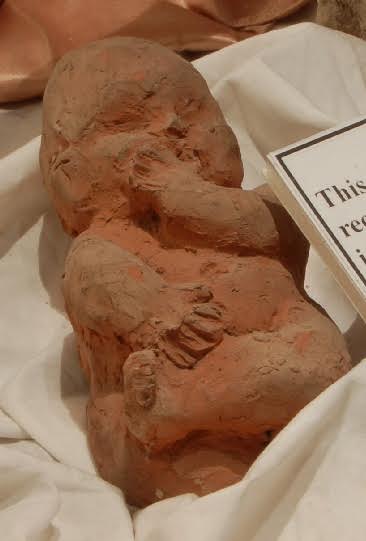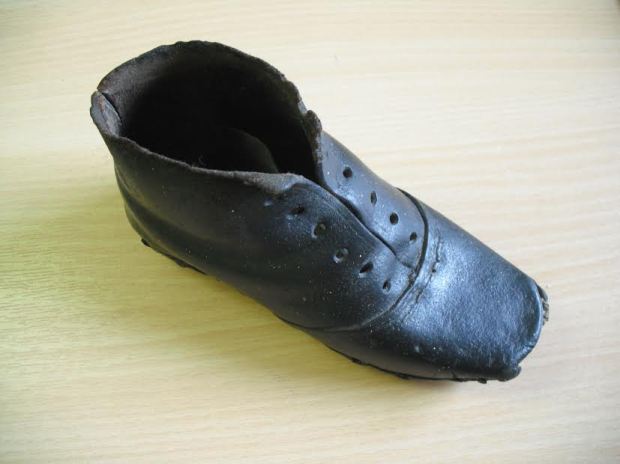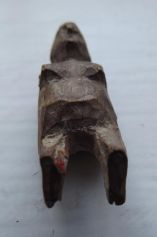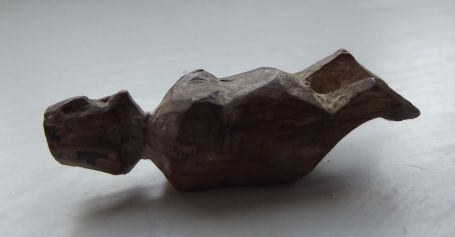Concealed Fertility Charms
The Perceptions of Pregnancy blog, like the Researchers’ Network, aims to reach beyond boundaries and borders, and to facilitate an international and interdisciplinary conversation on pregnancy and its associated bodily and emotional experiences from the medieval to the modern. Today’s post from Ceri Houlbrook explores concealed fertility charms.
In October 2015 I was contacted by a man named Roy Carter who’d been renovating a Tudor cottage in Burwash, East Sussex. During renovations he’d found a small wooden figurine, about an inch and a half long, which he believes had been deliberately concealed within the cottage, either placed above a roof beam or within one of the walls. This certainly isn’t the first obscure object to have been found secreted away within a domestic space. All manner of items have been discovered – from shoes and bottles to animal remains – in unusual locations: within walls; under floorboards, hearthstones, and thresholds; above doors and ceilings; up chimney breasts; in thatching; and buried in gardens. The majority of these items date to the 18th and 19thcenturies, and appear to have been deliberately concealed rather than accidentally lost. But why?
Scholars have been unable to find much written evidence explaining this custom of concealment, so we have only theories. The most popular notion is that these items were hidden away in the post-medieval home to protect its occupants from malevolent forces, both natural (fire, disease) and supernatural (witches, demons, ghosts). There is, however, another theory – and for this we need to take a closer look at the Burwash figurine.
Although crudely executed, the figurine does appear to have breasts, and when flat on its back, it looks decidedly pregnant. Was it intended to depict a pregnant woman? It also has two small holes in its back which, coupled with its small size, suggests that it may have originally hung on a thread. Was it worn as a charm? And, if so, was it associated with fertility magic, worn and maybe later concealed by a woman hoping to conceive or to bear healthy children?
Other figurines, known as poppets and made from a variety of materials (wood, clay, cloth, straw, wax, etc.), have been found hidden away in buildings. Not all of them would have been concealed for fertility magic. Some, which have been burnt or pricked with pins, were probably used in maleficium (harmful magic), whilst others were possibly concealed for luck, protection, or as a form of foundation sacrifice. But some do clearly have a connection with fertility; there is, for example, a rather uncanny foetus-like terracotta figure held at the Boscastle Museum of Witchcraft & Magic, found bricked-up in a wall in a house in Okehampton, Devon. Was this concealed to ensure fertility or the safe delivery of a baby?

The Okehampton poppet. Photograph courtesy of the Museum of Witchcraft & Magic, Boscastle.
Other objects may have been concealed for similar purposes: shoes, for example. Roughly 2000 finds are on record in the Northampton Museum Concealed Shoe Index, having been found worldwide, although primarily in England. As with other hidden objects, they’re often found up chimneybreasts, in roof spaces, and in walls, and mainly date to the 18th and 19th centuries. All kinds of shoes are represented: working-class hobnailed boots, higher-class court shoes, women’s lace-up boots, and children’s shoes, which account for 29% of those on record.[1] The presence of children’s shoes has led some researchers to suggest that they may have been concealed in connection with fertility magic.
Shoes are, after all, often associated with concepts of fertility. If, for example, a woman places a shoe on a table it foretells the birth of a child.[2] In Lancashire, if you try on the shoes of a woman who has recently given birth then you too will soon conceive.[3] Additionally, the practice of throwing shoes – and later, shoe-shaped confetti – at a wedding possibly stems from some notion of deterring demons who may cause barrenness.[4] Shoes were also used as a form of protection for children; a north German superstition, for example, maintained that so long as a child’s first shoe is kept within the home, the child will come to no harm.[5]

A child’s shoe found concealed up a chimneybreast in a farmhouse in Ilkley,Yorkshire. Photograph by Ceri Houlbrook.
As stated above, these are all just theories. Of course, different objects were probably concealed for different reasons, and there’s no way of knowing what those reasons were. But the general consensus does appear to be that the custom of concealment was motivated by anxiety, whether concern about disease and fire or fear of witches and demons. Fertility rites would fit with this theory: childbearing is, after all, rife with anxiety. As they do now, hope, worry, and fear surrounded conception, pregnancy, childbirth, and the wellbeing of the baby once it’s delivered. So is it surprising that people would employ any means available to them in order to increase the chances of a successful pregnancy?
[1] Swann, J. 2015. Shoes Concealed in Buildings. In Hutton, R. (ed.) Physical Evidence for Ritual Acts, Sorcery and Witchcraft in Christian Britain: A Feeling for Magic. Basingstoke: Palgrave Macmillan, 118-130, 121
[2] Radford, E. & Radford, M. A. 1948. Encyclopaedia of Superstitions. London: Hutchinson, 305
[3] Merrifield, R. 1987. The Archaeology of Ritual and Magic. London: Batsford, 134
[4] MacCulloch, J. A. 1920. Shoes and sandals, in Encyclopaedia of Religion and Ethics, vol. 3, eds. J. Hastings, L. H. Gray & J. A. Selvia. Edinburgh: T. & T. Clark, 476
[5] van Driel-Murray. C. 1999. And did those feet in ancient time … feet and shoes as a material projection of the self, in Trac 98: Proceedings of the Eighth Annual Theoretical Roman Archaeology Conference Leicester 1998, eds. P. Baker, C. Forcey, S. Jundi & R. Witcher. Oxford: Oxbow Books, 131–40, 136.
Bio: With a PhD in Archaeology, Ceri Houlbrook considers herself a historical ethnographer and archaeologist, and is particularly interested in the material culture of popular customs and beliefs. She’s currently a Postdoctoral Researcher on the ‘Inner Lives: Emotions, Identity and the Supernatural, 1300-1900’ project at the University of Hertfordshire, working alongside Prof. Owen Davies on the ‘Concealed Revealed’. This project strand is aiming to survey concealed deposits across the British Isles and beyond, and to consider the ‘afterlives’ of these hidden objects by engaging with their contemporary finders and custodians. Please visit the project website (https://theconcealedrevealed.wordpress.com/), add a find yourself to our growing survey on Historypin (https://www.historypin.org/en/person/66740), or contact Ceri directly with any knowledge, ideas, or stories you have on c.houlbrook@herts.ac.uk or Twitter @ConcealReveal.

